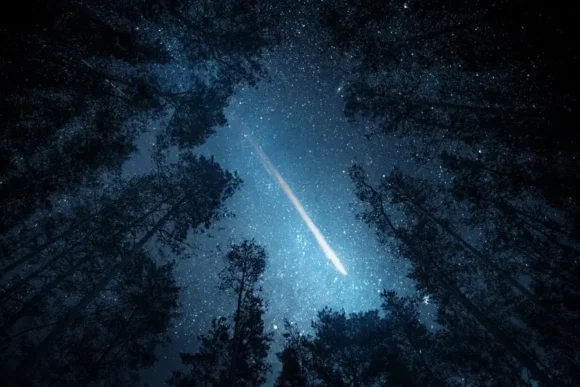How likely is it that we’re not alone in the universe? The idea goes in and out of fashion. In 1600 the philosopher Giordano Bruno was burned at the stake for this and other heterdox beliefs. Exactly 300 years later the French Académie des sciences announced a prize for establishing communication with life anywhere but on Earth or Mars — since people already assumed that Martians did exist.
The problem — and it’s the speck of grit around which these two wildly different books accrete — is that we’re the only life we know of. “We are both the observer and the observation,” says Nathalie Cabrol, chief scientist at the SETI Institute in California and author of The Secret Life of the Universe, already a bestseller in her native France: “we are life trying to understand itself and its origin.”
Cabrol reckons this may be only a temporary problem, and there are two strings to her optimistic argument.
First, the universe seems a lot more amenable toward life than it used to. Not long ago, and well within living memory, we didn’t know whether stars other than our sun had planets of their own, never mind planets capable of sustaining life. The Kepler Space Telescope, launched in March 2009, changed all that. Among the wonders we’ve detected since — planets where it rains molten iron, or molten glass, or diamonds, or metals, or liquid rubies or sapphires — are a number of rocky planets, sitting in the habitable zones of their stars, and quite capable of hosting oceans on their surface. Well over half of all sun-like stars boast such planets. We haven’t even begun to quantify the possibility of life around other kinds of star. Unassuming, plentiful and very long-lived M-dwarf stars might be even more life-friendly.
Then there are the ice-covered oceans of Jupiter’s moon Europa, and Saturn’s moon Enceladus, and the hydrocarbon lakes and oceans of Saturn’s Titan, and Pluto’s suggestive ice volcanoes, and — well, read Cabrol if you want a vivid, fiercely intelligent tour of what may turn out to be our teeming, life-filled solar system.
The second string to Cabrol’s argument is less obvious, but more winning. We talk about life on Earth as if it’s a single family of things, with one point of origin. But it isn’t. Cabrol has spent her career hunting down extremophiles (ask her about volcano diving in the Andes) and has found life “everywhere we looked, from the highest mountain to the deepest abyss, in the most acidic or basic environments, the hottest and coldest regions, in places devoid of oxygen, within rocks — sometimes under kilometers of them — within salts, in arid deserts, exposed to radiation or under pressure”.
Several of these extremophiles would have no problem colonising Mars, and it’s quite possible that a more-Earth-like Mars once seeded Earth with life.
Our hunt for earth-like life — “life like ours” — always had a nasty circularity about it. By searching for an exact mirror of ourselves, what other possibilities were we missing? In The Secret Life Cabrol argues that we now know enough about life to hunt for radically strange lifeforms, in wildly exotic environments.
Sara Imari Walker agrees. In Life As No One Knows It, the American theoretical physicist does more than ask how strange life may get; she wonders whether we have any handle at all on what life actually is. All these words of ours — living, lifelike, animate, inanimate, — may turn out to be hopelessly parochial as we attempt to conceptualise the possibilities for complexity and purpose in the universe. (Cabrol makes a similar point: “Defining Life by describing it,” she fears, “as the same as saying that we can define the atmosphere by describing a bird flying in the sky.”
Walker, a physicist, is painfully aware that among the phenomena that current physics can’t explain are physicists — and, indeed, life in general. (Physics, which purports to uncover an underlying order to reality, is really a sort of hyper-intellectual game of whack-a-mole in which, to explain one phenomenon, you quite often have to abandon your old understanding of another.) Life processes don’t contradict physics. But physics can’t explain them, either. It can’t distinguish between, say, a hurricane and the city of New York, seeing both as examples of “states of organisation maintained far from equilibrium”.
But if physics can’t see the difference, physicists certainly can, and Walker is a fiercely articulate member of that generation of scientists and philosophers — physicists David Deutsch and Chiara Marletto and the chemist Leroy Cronin are others — who are out to “choose life”, transforming physics in the light of evolution.
We’re used to thinking that living things are the product of selection. Walker wants us to imagine that every object in the universe, whether living or not, is the product of selection. She wants us to think of the evolutionary history of things as a property, as fundamental to objects as charge and mass are to atoms.
Walker’s defence of her “assembly theory” is a virtuoso intellectual performance: she’s like the young Daniel Dennett, full of wit, mischief and bursts of insolent brevity which for newcomers to this territory are like oases in the desert.
But to drag this back to where we started: the search for extraterrestrial life — did you know that there isn’t enough stuff in the universe to make all the small molecules that could perfom a function in our biology? Even before life gets going, the chemistry from which it is built has to have been massively selected — and we know blind chance isn’t responsible, because we already know what undifferentiated masses of small organic molecules look like; we call this stuff tar.
In short, Walker shows us that what we call “life” is but an infinitesimal fraction of all the kinds of life which may arise out of any number of wholly unfamiliar chemistries.
“When we can run origin-of-life experiments at scale, they will allow us to predict how much variation we should expect in different geochemical environments,” Walker writes. So once again, we have to wait, even more piqued and anxious than before, to meet aliens even stranger than we have imagined or maybe can imagine.
Cabrol, in her own book, makes life even more excruciating for those of us who just want to shake hands with E.T.: imagine, she says, “a shadow biome” of living things so strange, they could be all around us here, on Earth — and we would never know.



